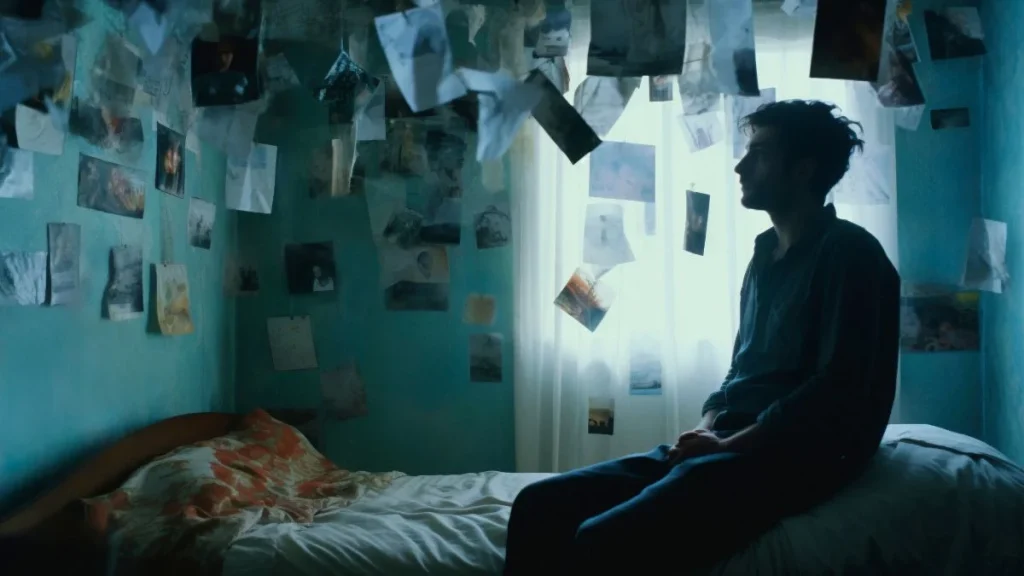What happens when the pursuit of happiness turns into a nightmare?
This is the chilling question at the heart of Requiem for a Dream, a film that has haunted audiences since its release in 2000. Directed by Darren Aronofsky, Requiem for a Dream is not just a movie—it’s an unflinching psychological drama that dives deep into the human psyche, exposing the raw and devastating consequences of addiction and broken dreams.
From its opening frames, Requiem for a Dream sets itself apart as a cinematic experience that is as visually arresting as it is emotionally shattering. The film follows four characters, each chasing their own version of the American Dream, only to find themselves ensnared in a web of obsession, dependency, and despair. Through its innovative storytelling, unforgettable performances, and a haunting musical score, the film has become a cultural touchstone, sparking conversations about addiction, mental health, and the cost of chasing unattainable ideals.
More than two decades after its debut, Requiem for a Dream remains as relevant as ever. In an era marked by opioid epidemics and growing awareness of mental health struggles, the film’s portrayal of addiction feels both timely and timeless. Its impact is felt not only in the world of cinema but also in classrooms, therapy sessions, and public discourse, where it serves as a powerful reminder of the fragility of hope and the dangers of self-destruction.
In this comprehensive exploration, we’ll delve into the origins of Requiem for a Dream, unravel its complex characters and plot, analyze its themes and symbolism, and examine the cinematic techniques that make it a masterpiece of psychological drama. Whether you’re a longtime fan or a newcomer, this deep dive will reveal why Requiem for a Dream continues to captivate, disturb, and enlighten audiences around the world.
1. Background and Origins
The story of Requiem for a Dream begins long before its haunting ornery images flickered across movie screens. The film is based on the 1978 novel of the same name by Hubert Selby Jr., a writer renowned for his unvarnished depictions of urban despair and human frailty. Selby’s novel is a modern tragedy, chronicling the lives of four New Yorkers—Harry Goldfarb, his mother Sara, his girlfriend Marion, and his friend Tyrone—as they spiral into addiction while chasing their own versions of happiness .
Darren Aronofsky, a rising filmmaker at the time, was deeply moved by Selby’s work. Determined to bring the novel’s raw emotional power to the screen, Aronofsky collaborated closely with Selby on the screenplay. The adaptation process was not without its challenges. Translating the novel’s stream-of-consciousness style and bleak subject matter into a visual medium required bold creative choices. Aronofsky updated the setting to the late 1990s, making the story feel immediate and relevant to contemporary audiences .
Filming took place in Brooklyn, New York, particularly around Coney Island, which serves as both a literal and symbolic backdrop for the characters’ dreams and downfalls. The film’s runtime is a taut 102 minutes, but every second is packed with emotional intensity. The principal cast features Ellen Burstyn as Sara Goldfarb, Jared Leto as Harry, Jennifer Connelly as Marion Silver, and Marlon Wayans as Tyrone C. Love. Each actor delivers a performance that is both nuanced and unforgettable, bringing depth and humanity to characters who might otherwise be reduced to cautionary tales .
One of the film’s most distinctive elements is its score, composed by Clint Mansell and performed by the Kronos Quartet. The music, especially the iconic “Lux Aeterna,” weaves through the film like a ghostly refrain, amplifying the sense of dread and inevitability that permeates the story. Matthew Libatique’s cinematography employs rapid cuts, split screens, and innovative camera techniques to immerse viewers in the characters’ fractured realities .
Aronofsky’s vision was to create a film that was as emotionally overwhelming as the experience of addiction itself. Through a combination of daring direction, powerful performances, and a relentless visual and auditory assault, Requiem for a Dream achieves this goal, leaving an indelible mark on all who watch it .
2. Plot Summary and Character Arcs
At its core, Requiem for a Dream is a story about four people whose dreams become their undoing. Each character is driven by a longing for something better, but their paths are twisted by addiction, leading to tragic consequences.
Sara Goldfarb: The Dream of Recognition
Sara Goldfarb, a lonely widow living in a small Brooklyn apartment, spends her days watching television and reminiscing about happier times. When she receives a phone call inviting her to appear on a game show, Sara becomes obsessed with the idea of reclaiming her youth and fitting into her beloved red dress. To lose weight, she begins taking amphetamines prescribed by her doctor. What starts as a hopeful quest for self-improvement quickly devolves into amphetamine psychosis. Sara’s world becomes a nightmare of hallucinations, paranoia, and delusion, culminating in a harrowing sequence where she is subjected to electroconvulsive therapy in a psychiatric hospital .
Harry Goldfarb: The Illusion of Escape
Harry, Sara’s son, is a young man with dreams of escaping his bleak surroundings. Alongside his girlfriend Marion and best friend Tyrone, Harry turns to dealing heroin as a means to a better life. The trio initially experiences a fleeting sense of hope and prosperity, envisioning a future where they can leave their troubles behind. However, their heroin addiction tightens its grip, leading to a series of increasingly desperate decisions. Harry’s health deteriorates as his arm becomes infected from repeated injections. In a final, desperate attempt to score drugs, Harry and Tyrone travel south, only to be arrested. Harry’s journey ends in a hospital, where his arm is amputated, and his dreams are irrevocably shattered .
Marion Silver: The Price of Desperation
Marion Silver, Harry’s girlfriend, is an aspiring fashion designer with dreams of opening her own clothing store. Her relationship with Harry is passionate but co-dependent, and together they spiral deeper into addiction. As their financial situation worsens and their supply of heroin dries up, Marion is forced to make heartbreaking choices. In one of the film’s most disturbing sequences, she resorts to prostitution to feed her addiction, sacrificing her dignity and self-worth. Marion’s story is a devastating portrait of how addiction can strip away not only dreams but also identity .
Tyrone C. Love: The Weight of the Past
Tyrone, Harry’s loyal friend and partner in crime, is haunted by memories of his mother and a longing for a better life. His journey is marked by both hope and tragedy, as he faces the dual burdens of addiction and systemic racism. After being arrested with Harry, Tyrone is sent to a brutal prison, where he is subjected to hard labor and racial abuse. His dreams of escape and redemption are crushed, leaving him isolated and broken .
The Downward Spiral
The film’s narrative is structured around the changing seasons—summer, fall, and winter—mirroring the characters’ descent from hope to despair. As their addictions worsen, their worlds become increasingly claustrophobic and surreal. The climactic sequences are a barrage of rapid cuts, hallucinations, and emotional breakdowns, culminating in a series of devastating final images: Sara catatonic in a hospital, Harry alone and maimed, Marion clutching a bag of drugs, and Tyrone weeping in his prison cell.
Requiem for a Dream is not just a story of addiction; it is a requiem—a mournful reflection on the death of dreams and the human cost of chasing illusions .
3. Themes and Symbolism
Requiem for a Dream is a film rich in themes and symbolism, using its characters’ journeys to explore universal questions about desire, reality, and the human condition.
Addiction as a Universal Metaphor
While the film’s most obvious subject is drug addiction, Aronofsky and Selby use addiction as a broader metaphor for obsession and self-destruction. Each character is addicted not only to substances but also to the idea of a better life—whether it’s fame, love, or escape. Their compulsions drive them to make choices that ultimately destroy them, illustrating how the pursuit of happiness can become a trap .
Dreams vs. Harsh Reality
The tension between dreams and reality is at the heart of the film. Sara’s fantasy of appearing on television is contrasted with her grim existence, while Harry, Marion, and Tyrone’s dreams of success are constantly undermined by their circumstances and choices. The film critiques the seductive allure of the American Dream, showing how it can be both inspiring and destructive, especially for those on the margins of society .
Loneliness and Isolation
Despite their connections, the characters are profoundly alone. The use of split screens and fragmented editing visually represents their emotional isolation, even when they are physically together. Sara’s hallucinations, particularly her conversations with her refrigerator and television, underscore her loneliness and detachment from reality .
Symbolic Imagery
- The Red Dress: Sara’s red dress is a potent symbol of her longing for youth, beauty, and acceptance. It represents both hope and delusion, as her pursuit of fitting into the dress leads to her psychological unraveling.
- The Refrigerator: As Sara’s addiction worsens, her refrigerator becomes a menacing presence, symbolizing her growing paranoia and the inescapable nature of her fears.
- Seasonal Structure: The film’s division into summer, fall, and winter mirrors the characters’ emotional trajectories, with each season marking a further step into darkness and despair .
The Haunting Score
Clint Mansell’s score, particularly “Lux Aeterna,” is more than just background music—it is an emotional undercurrent that amplifies the film’s sense of inevitability and loss. The music’s repetitive, mournful quality echoes the characters’ cycles of hope and disappointment, making the film’s emotional impact even more profound .
Through its themes and symbolism, Requiem for a Dream offers a powerful commentary on the dangers of unchecked desire and the societal forces that shape our dreams and destinies .
4. Cinematic Techniques and Style
Darren Aronofsky’s Requiem for a Dream is as much a triumph of style as it is of substance. The film’s innovative cinematic techniques are integral to its emotional impact, immersing viewers in the chaotic and disorienting world of its characters.
Fast Cuts and Hip-Hop Montage
One of the film’s most distinctive stylistic choices is the use of rapid-cut montages, often referred to as “hip-hop montages.” These sequences use a series of quick, repetitive shots—such as pupils dilating, drugs being prepared, and blood flowing—to convey the ritualistic nature of addiction. The technique creates a sense of urgency and compulsion, mirroring the characters’ psychological states .
Split Screens and Visual Fragmentation
Aronofsky frequently employs split screens to show simultaneous actions or to highlight the emotional distance between characters. This visual fragmentation reinforces the theme of isolation and the inability of the characters to truly connect with one another, even in moments of intimacy .
SnorriCam and Point-of-View Shots
The use of the SnorriCam—a camera rig attached to the actor’s body—creates a disorienting, first-person perspective that pulls the audience into the characters’ experiences. This technique is particularly effective in scenes depicting drug use or psychological breakdowns, making the viewer feel the characters’ confusion and distress .
Lighting and Color Palette
The film’s visual style shifts dramatically as the story progresses. Early scenes are bathed in warm, hopeful tones, while later sequences become increasingly cold and desaturated, reflecting the characters’ descent into despair. The changing color palette serves as a visual metaphor for the loss of hope and vitality .
Sound Design and Score
Clint Mansell’s score, performed by the Kronos Quartet, is a central element of the film’s atmosphere. The music’s haunting melodies and relentless rhythms heighten the sense of tension and inevitability. Sound effects—such as the buzzing of the refrigerator or the cacophony of television static—are used to convey the characters’ psychological states and to blur the line between reality and hallucination .
Editing and Viewer Experience
The film’s editing is relentless, building tension and conveying the chaos of addiction. The rapid pace and sensory overload can be overwhelming, but this is precisely the point: Aronofsky wants the audience to feel the same sense of disorientation and desperation as the characters. The result is an immersive, harrowing viewing experience that lingers long after the credits roll .
Through these techniques, Requiem for a Dream pushes the boundaries of cinematic storytelling, using every tool at its disposal to create a visceral and unforgettable portrait of addiction .
5. Critical Reception and Legacy
Upon its release, Requiem for a Dream was met with both acclaim and controversy. Critics praised the film’s bold storytelling, innovative direction, and unflinching portrayal of addiction. Ellen Burstyn’s performance as Sara Goldfarb was particularly lauded, earning her an Academy Award nomination for Best Actress—a testament to the emotional depth and authenticity she brought to the role .
The film’s graphic content and disturbing imagery led to an NC-17 rating from the MPAA, which limited its initial release but also contributed to its reputation as a daring and uncompromising work of art. Despite—or perhaps because of—its challenging subject matter, the film quickly gained a cult following, becoming a staple in discussions about addiction and psychological drama .
Requiem for a Dream garnered several awards and nominations, including recognition for its cinematography, editing, and score. Darren Aronofsky’s direction was widely praised for its originality and emotional intensity, establishing him as a major voice in contemporary cinema .
Beyond its critical success, the film has had a profound cultural impact. Its influence can be seen in subsequent films and television shows that tackle addiction and mental health with similar honesty and stylistic innovation. The haunting score by Clint Mansell, especially “Lux Aeterna,” has been used in countless trailers, commercials, and other media, further cementing the film’s place in popular culture .
Perhaps most importantly, Requiem for a Dream has become an educational tool, used by teachers, therapists, and prevention programs to spark conversations about the realities of addiction. Its emotional difficulty is undeniable, but so is its importance in fostering empathy and understanding for those struggling with substance abuse .
Even decades after its release, the film remains a touchstone for discussions about the human cost of addiction, the power of cinema to provoke and enlighten, and the enduring relevance of stories that refuse to look away from life’s darkest corners .
6. Why Requiem for a Dream Matters Today
In the years since its release, Requiem for a Dream has only grown in relevance. As the United States and much of the world grapple with opioid epidemics, rising rates of mental health issues, and the persistent allure of unattainable dreams, the film’s message feels more urgent than ever .
Addiction in the Modern Era
The film’s portrayal of addiction is unflinching and universal. It shows how substance abuse can affect anyone, regardless of age, race, or background. The characters’ struggles mirror those faced by millions today, making the film a powerful tool for raising awareness and fostering empathy .
Mental Health Awareness
Requiem for a Dream also shines a light on the psychological toll of addiction. Sara’s descent into amphetamine psychosis, Harry’s emotional unraveling, and Marion’s loss of self-worth all highlight the complex interplay between mental health and substance abuse. The film’s focus on internal struggles aligns with contemporary efforts to destigmatize mental illness and promote holistic approaches to treatment .
Lessons for Prevention and Empathy
By refusing to offer easy answers or tidy resolutions, the film challenges viewers to confront the realities of addiction and to consider the societal factors that contribute to it. Its depiction of loneliness, desperation, and the shattering of dreams resonates with audiences facing similar challenges in today’s fast-paced, often isolating world.
Educators and advocates continue to use the film as a starting point for discussions about prevention, treatment, and the importance of compassion for those affected by addiction. Its enduring power lies in its ability to make viewers feel—not just understand—the pain and complexity of its characters’ journeys .
Key Takeaways
The Enduring Power of Requiem for a Dream
- A Landmark in Psychological Drama: Requiem for a Dream stands as one of the most powerful and innovative films about addiction ever made, blending raw storytelling with groundbreaking cinematic techniques.
- Universal Themes: The film’s exploration of addiction, dreams, and isolation resonates across generations and cultures, making it a timeless cautionary tale.
- Cultural and Educational Impact: Beyond its artistic achievements, the film has influenced public discourse on addiction and mental health, serving as both a warning and a call for empathy.
- Unforgettable Performances: The cast, led by Ellen Burstyn, delivers performances that are both heartbreaking and deeply human, grounding the film’s stylized approach in emotional truth.
- A Call to Reflection: More than just a movie, Requiem for a Dream is an invitation to reflect on the nature of desire, the cost of obsession, and the importance of compassion in the face of suffering.
Conclusion
Requiem for a Dream is not an easy film to watch, but it is an essential one. Through its unflinching portrayal of addiction and its devastating consequences, the film forces viewers to confront uncomfortable truths about the human condition. Darren Aronofsky’s visionary direction, combined with unforgettable performances and a haunting score, creates an experience that is as emotionally overwhelming as it is artistically brilliant.
The film’s legacy endures because it refuses to offer false hope or easy answers. Instead, it presents a sobering reminder of the fragility of dreams and the dangers of chasing happiness at any cost. In a world where addiction and mental health challenges are more visible than ever, Requiem for a Dream remains a vital work—one that demands empathy, understanding, and action.
For those who have seen the film, its images and emotions linger long after the credits roll. For those who have yet to experience it, Requiem for a Dream offers not just a story, but a journey into the heart of human longing and loss. Whether you watch it as a cautionary tale, a work of art, or a catalyst for conversation, the film’s message is clear: dreams can inspire, but they can also destroy. It is up to us to recognize the difference, to support those in need, and to never lose sight of our shared humanity.
If you or someone you know is struggling with addiction, remember that help is available. Let the lessons of Requiem for a Dream inspire not just reflection, but action—toward understanding, prevention, and healing.







